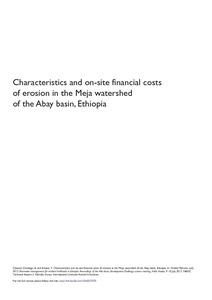Resource information
Most soil erosion studies conducted in Ethiopia are focused on quantification of sediment and lack specific information on temporal and spatial variability of sediment and its associated plant nutrients loss. This study was, therefore quantified and characterized runoff and sediment along with estimated the on-site financial cost of erosion in terms of its concomitant crop yield loss due to the nitrogen and phosphorus lost in consequence of erosion. Data on discharge and runoff samples for sediment concentration and nutrient content was collected at three monitoring stations (Melka, Galesssa and Kollu) in Meja watershed in Jeldu district, in the Ethiopian part of the Blue Nile Basin. Daily samples collected during the rainy season were analysed in the laboratory of Ambo University for sediment content of runoff, particle size distribution of the sediment and nitrogen and phosphorus content of both the sediment and runoff. Preliminary results indicate that both runoff volume and sediment concentration vary with space and time. While the maximum runoff volume was recorded in the middle of the rainy season, sediment concentration decreased towards the end of the rainy season in response to increased ground cover. The average suspended sediment concentration during the rainy season was 3.0 ± 1.1, 2.2 ±1.3 and 1.4 ± 0.9 g L-1 while the total sediment yield ranged from 74 t km-2, 248 t km-2 and 604 t km-2 at Melka, Galesssa and Kollu, respectively. The financial cost of erosion was estimated at 595, 510 and 2475 ETB ha-1 from Melka, Kollu and Galessa, respectively.



